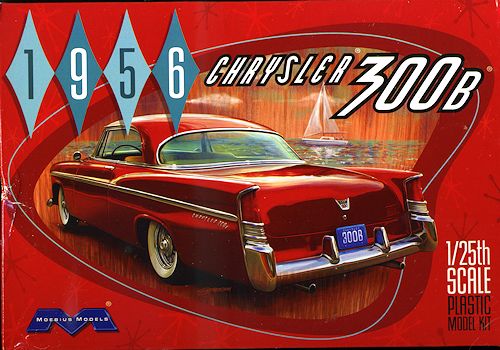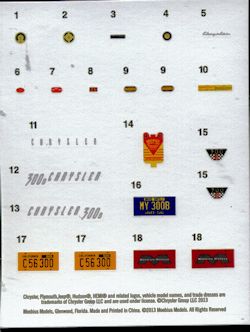
Moebius 1/25 1956 Chrysler 300B
| KIT #: | 1207 |
| PRICE: | $27.95 SRP |
| DECALS: | Several license options |
| REVIEWER: | Scott Van Aken |
| NOTES: |

| HISTORY |
The Chrysler 300 "letter series" were high-performance luxury cars built in very limited numbers by the Chrysler Corporation in the U.S. from 1955–1965. Each year's model used a new letter of the alphabet as a suffix (skipping "i"), reaching 300L by 1965, after which the model was dropped.
The 300 "letter series" cars were among the vehicles that focused on performance built by domestic U.S. manufacturers after World War II, and thus can be considered one of the muscle car's ancestors, though much more expensive and exclusive.
Chrysler has recently started using these designations again for sporting high performance-luxury sedans, using 300M from 1999, and continuing the 300 series with a new V8-powered 300C, the top model of a relaunched Chrysler 300 line, a new rear-wheel drive car launched in 2004 for the 2005 model year. Unlike the first series, the second does not have 300 hp (220 kW) engines, except for Chrysler's current top-line 300C models.
This first of the letter series cars didn't actually bear a letter; it can retroactively be considered the '300A'. The 'C-' designation was applied to all Chrysler models, however for marketing purposes the numerical series skipped more than 225 numbers forward in sequence in order to further reinforce the 300's bhp rating. The 300 originally stood for the 300 hp (220 kW) engine. The C-300 was really a racecar aimed at the NASCAR circuits that was sold for the road for homologation purposes, with Chrysler's most powerful engine, the 331 cu in (5.4 L) FirePower "Hemi" V8, due to the hemisperic shape of the combustion chambers, fitted with twin 4-barrel carburetors, a race-profiled camshaft setup, solid valve lifters, stiffer suspension and a performance exhaust system. By 1956 this would be the first American production car to top 355 hp (265 kW), and the letter series was for many years the most powerful car produced in the United States.
The car's "Forward Look" styling can be attributed as much to the Chrysler parts bin as designer Virgil Exner. The front clip, including the grille, was taken from the Imperial of the same year, but the rest of the car did not look like an Imperial. The midsection was from a New Yorker hardtop, with a Windsor rear quarter. Exner also included base-model Chrysler bumpers and removed many exterior elements such as back-up lights, hood ornament, side trim, and exterior mirrors. An electric clock and two-speed windshield wipers were standard. There were few options available including selection of three exterior colors (red, white and black) and only one color of tan leather interior. Power windows and power seat were available but air conditioning was not available in 1955. At least one known 1955 C-300 had A/C as a special order for a Chrysler executive.
Measured at 127.58 mph (205.32 km/h) in the Flying Mile, and doing well in NASCAR, the C-300 aroused a lot of interest that was not reflected in its modest sales figure of 1,725 built.
When the C300 competed in NASCAR, it was painted to advertise that it was the "world's fastest stock car".
The 1956 300B was fairly similar externally, distinguished by a new tailfin treatment, but with larger engines, two models of 354 cu in (5.8 L) Hemi V8 with either 340 or 355 hp (254 or 265 kW). Only 1,102 were sold. Performance was a little better than the previous year's, being measured at almost 140 mph (225 km/h). A 6.17 ratio rear end was also added to the options. Front leg room was 44.6 inches. New was the Highway Hi-Fi phonograph player.
With the optional 355 hp 354 cu.in engine, the 300B became the first American car to produce 1 horsepower per cubic inch, besting Chevrolet with their fuel-injected 283 cu in (4.6 L) by one year.
| THE KIT |
I was curious to see just what sort of car kit Moebius could produce, so using some of my store credit, I picked this one up. Even before removing the shrink wrap, I saw that the kit was bulging the box a bit. Opening it up, I was confronted by well molded, flash free plastic; a lot of it. As a note, there is no sprue layout in the instructions, which is typical for US car kits, and since I don't open bags on kits I buy until I start construction, there is no view of the kit's parts.
To my eye, the molding is not as crisp as I've seen in kits from other companies, however, it is still quite well done. For those of you who build a lot of cars, I'd put it on a par with a good AMT kit, but not quite as crisp as what is offered by Monogram. You get a nicely done one-piece body that shows this is not a small car. A full engine is provided that offers detail that will disappear when most of us complete it. For instance, you get valve train detail on the heads as well as detail on the other side and the intake manifold as well. This will benefit those who want to build a diorama of engine work being done, but most of us will simply have it disappear under valve covers and air cleaners. The two four-barrel carburetors are nicely molded and the engine has superbly done accessory bits and exhaust.
Wheels are two piece and Moebius includes wide white-wall tires. For the interior there are side panels as well as the full width front and rear bench seats. A nicely done dash is provided along with a proper steering wheel. On the underside of the chassis are separate shocks, steering gear with separate upper and lower A-arms. Dual exhaust is also provided along with nicely detailed rear springs and rear axle housing with a separate differential section.
Clear bits consist of a windscreen and rear window. Vent
windows are separat e
items as well. There are several chrome trees and the chrome is very nicely one.
Included in the chrome are separate exterior door handles. To display the
engine, one has to choose the open hood option that has to install the hood
hinges in the open position. The hood then fits atop those hinges.
e
items as well. There are several chrome trees and the chrome is very nicely one.
Included in the chrome are separate exterior door handles. To display the
engine, one has to choose the open hood option that has to install the hood
hinges in the open position. The hood then fits atop those hinges.
Instructions are first rate with one side in full color and the interior part with the construction sequences in a blue tint. One full page shows built up areas that include the interior, engine compartment, chassis underside, dashboard, engine out of the car and a front and rear three quarter view. These are also used to place the decals. On the back of the instructions is a table that shows what parts of the car are painted what color. All of them are referenced to Testors paint by name. Apparently this car was only available in three colors; red, black and white. For the exterior colors it does reference Testors paints, but recommends buying more closely matching lacquers from an aftermarket paint company. The decal sheet provided appears to be well done and in register.
| CONCLUSIONS |
Just looking at the build up photos as well as the kit parts, this one looks like a real beauty. It should build as well as any modern car kit and if you like American cars from this era, then this is a kit you really should consider picking up. It is a lot more expensive than when I was buying SMP kits in the late 1950s, but then you get a lot more and the price only a bit more than the standard nowadays.
| REFERENCES |
http://en.wikipedia.org/wiki/Chrysler_300_letter_series
February 2014 Thanks to me for picking up the preview kit. If you would like your product reviewed fairly and fairly quickly, please
contact
the editor or see other details in the
Note to
Contributors.